
A motherboard is the main printed circuit board (PCB) in general-purpose computers and other expandable systems. It holds and allows communication between many of the crucial electronic components of a system, such as the central processing unit (CPU) and memory, and provides connectors for other peripherals. Unlike a backplane, a motherboard usually contains significant sub-systems, such as the central processor, the chipset's input/output and memory controllers, interface connectors, and other components integrated for general use.

In computing, an expansion card is a printed circuit board that can be inserted into an electrical connector, or expansion slot on a computer's motherboard to add functionality to a computer system. Sometimes the design of the computer's case and motherboard involves placing most of these slots onto a separate, removable card. Typically such cards are referred to as a riser card in part because they project upward from the board and allow expansion cards to be placed above and parallel to the motherboard.

In computing, overclocking is the practice of increasing the clock rate of a computer to exceed that certified by the manufacturer. Commonly, operating voltage is also increased to maintain a component's operational stability at accelerated speeds. Semiconductor devices operated at higher frequencies and voltages increase power consumption and heat. An overclocked device may be unreliable or fail completely if the additional heat load is not removed or power delivery components cannot meet increased power demands. Many device warranties state that overclocking or over-specification voids any warranty, but some manufacturers allow overclocking as long as it is done (relatively) safely.

Inspiron is a line of consumer-oriented laptop computers, desktop computers and all-in-one computers sold by Dell. The Inspiron range mainly competes against Acer's Aspire; Asus's Transformer Book Flip, VivoBook and Zenbook; HP's Pavilion, Stream, and ENVY; Lenovo's IdeaPad; Samsung's Sens; and Toshiba's Satellite.
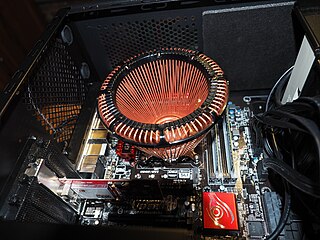
A quiet, silent or fanless PC is a personal computer that makes very little or no noise. Common uses for quiet PCs include video editing, sound mixing and home theater PCs, but noise reduction techniques can also be used to greatly reduce the noise from servers. There is currently no standard definition for a "quiet PC", and the term is generally not used in a business context, but by individuals and the businesses catering to them.

Thermoelectric cooling uses the Peltier effect to create a heat flux at the junction of two different types of materials. A Peltier cooler, heater, or thermoelectric heat pump is a solid-state active heat pump which transfers heat from one side of the device to the other, with consumption of electrical energy, depending on the direction of the current. Such an instrument is also called a Peltier device, Peltier heat pump, solid state refrigerator, or thermoelectric cooler (TEC) and occasionally a thermoelectric battery. It can be used either for heating or for cooling, although in practice the main application is cooling since heating can be achieved more efficiently with simpler devices. It can also be used as a temperature controller that either heats or cools.

Water cooling is a method of heat removal from components and industrial equipment. Evaporative cooling using water is often more efficient than air cooling. Water is inexpensive and non-toxic; however, it can contain impurities and cause corrosion.
Zalman Tech Co. is a South Korean software engineering company manufacturing aftermarket desktop computer products focusing on cooling enhancement.
Liquid cooling refers to cooling by means of the convection or circulation of a liquid.
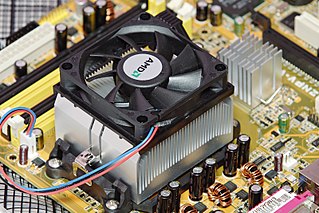
Computer cooling is required to remove the waste heat produced by computer components, to keep components within permissible operating temperature limits. Components that are susceptible to temporary malfunction or permanent failure if overheated include integrated circuits such as central processing units (CPUs), chipsets, graphics cards, hard disk drives, and solid state drives.
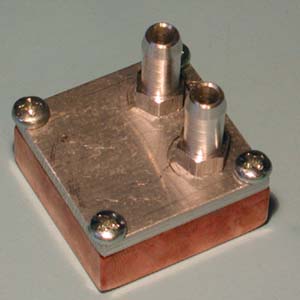
A water block is the watercooling equivalent of a heatsink. It is a type of plate heat exchanger and can be used on many different computer components, including the central processing unit (CPU), GPU, PPU, and northbridge chipset on the motherboard. There are also Monoblocks on the market that are mounted on PC motherboards and cover the CPU and its power delivery VRMs that surround the CPU socket area. It consists of at least two main parts; the "base", which is the area that makes contact with the device being cooled and is usually manufactured from metals with high thermal conductivity such as aluminum or copper. The second part, the "top" ensures the water is contained safely inside the water block and has connections that allow hosing to connect it with the water cooling loop. The top can be made of the same metal as the base, transparent Perspex, Delrin, Nylon, or HDPE. Most newer high-end water blocks also contain mid-plates which serve to add jet tubes, nozzles, and other flow altering devices.
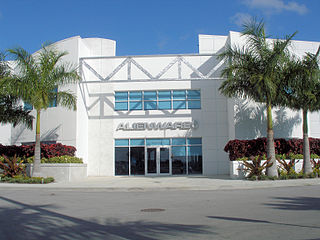
Alienware Corporation is an American computer hardware subsidiary brand of Dell. Their product range is dedicated to gaming computers and accessories and can be identified by their alien-themed designs. Alienware was founded in 1996 by Nelson Gonzalez and Alex Aguila. The development of the company is also associated with Frank Azor, Arthur Lewis, Joe Balerdi, and Michael S. Dell (CEO). The company's corporate headquarters is located in The Hammocks, Miami, Florida.

Dell XPS is a line of consumer-oriented laptop and desktop computers manufactured by Dell since 1993.
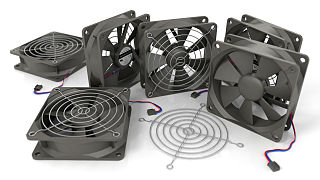
A computer fan is any fan inside, or attached to, a computer case used for active cooling. Fans are used to draw cooler air into the case from the outside, expel warm air from inside and move air across a heat sink to cool a particular component. Both axial and sometimes centrifugal (blower/squirrel-cage) fans are used in computers. Computer fans commonly come in standard sizes, such as 92 mm, 120 mm, 140 mm, and even 200–220 mm. Computer fans are powered and controlled using 3-pin or 4-pin fan connectors.
The AMD Quad FX platform is an AMD platform targeted at enthusiasts which allows users to plug two Socket F Athlon 64 FX or 2-way Opteron processors (CPUs) into a single motherboard for a total of four physical cores. This is a type of dual processor setup, where two CPUs are installed on a motherboard to increase computing power. The major difference between the platform and past dual processor systems like Xeon is that each processor has its own dedicated memory stores. The Quad FX platform also has HyperTransport capability targeted toward consumer platforms.
Solar air conditioning, or "solar-powered air conditioning", refers to any air conditioning (cooling) system that uses solar power.

The Enthusiast System Architecture (ESA) specification is a royalty-free protocol for two-way communication of PC components. Announced in 2007, ESA is used for monitoring temperature of computer hardware components such as the computer case and power supply unit. The first and last official release of the ESA specification is version 1.0, released in 2007. The ESA USB specification was created by a joint venture between Microsoft, Nvidia, Logitech and several other companies. The protocol remains open and royalty-free; but, no manufacturers are currently utilizing its specification at this time. The last known devices to utilize the ESA specifications were the Dell XPS 730x and Alienware Area-51 ALX computer systems that utilized the ESA specification to control its fans, LEDs, and motorized doors as well as the monitoring of available Water cooling systems such as the Dell XPS 730x's Dell H2Ceramic Cooling System.

Socket AM3+ is a modification of Socket AM3, which was released on February 9, 2009. AM3+ was released in mid-2011 designed for CPUs which use the AMD Bulldozer microarchitecture and retains compatibility with processors made for AM3. The Vishera line of AMD CPUs also all use Socket AM3+. It is the last AMD socket for which Windows XP support officially exists.

EKWB, better known as EK Water Blocks, is a Slovenian company founded in 2003 that manufactures high-end computer water cooling, extreme cooling, and some air cooling components for CPUs, GPU, RAM, and SSDs. Their target audience consists of custom PC building enthusiasts and professionals, and the company offers a wide range of water-cooling products. EKWB sells its products through several authorized distributors worldwide, but also maintains its web store focused on direct-to-consumer sales. Its primary brand strategy makes use of influencer marketing to advertise products through sponsorships or review samples.